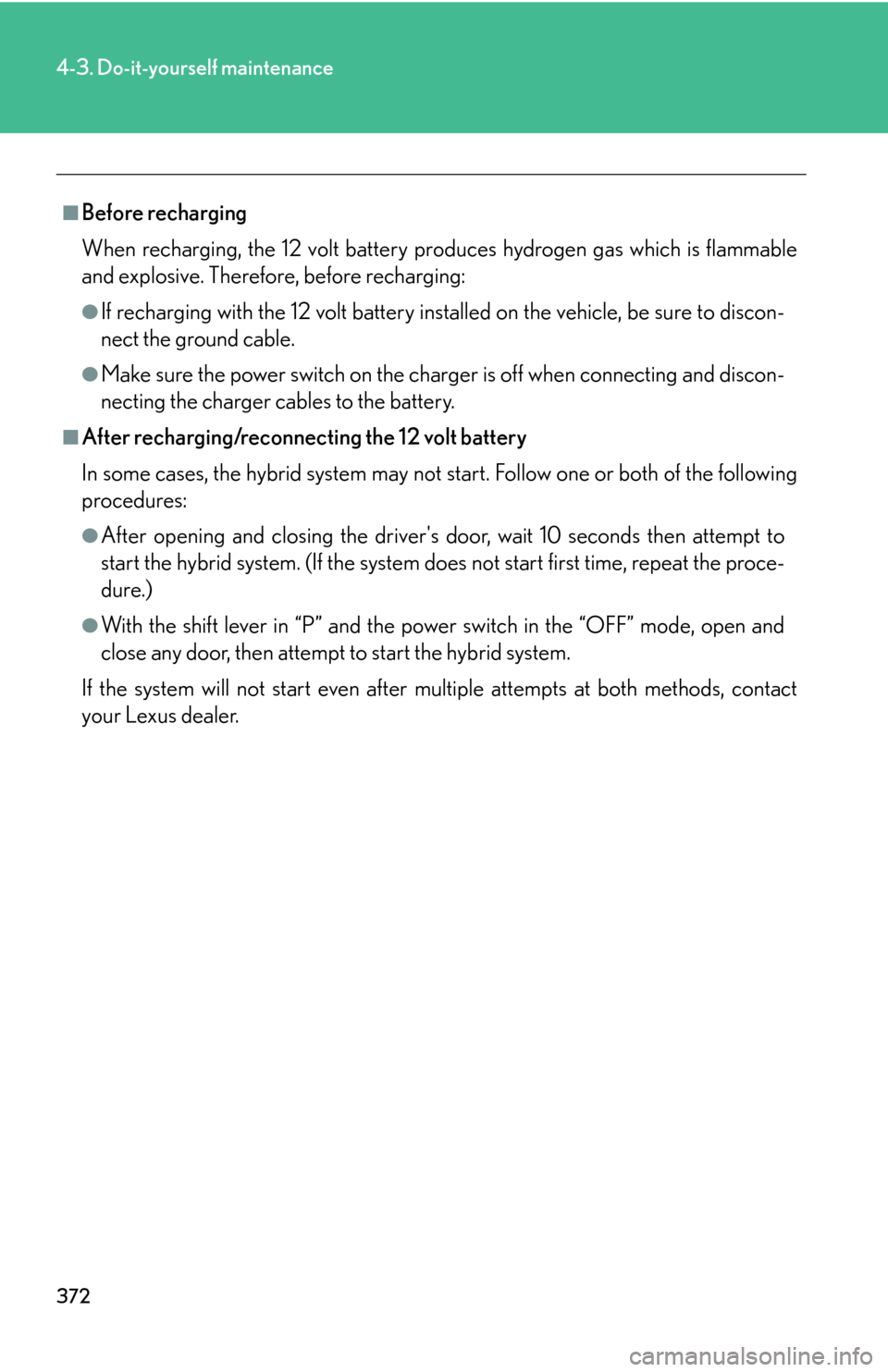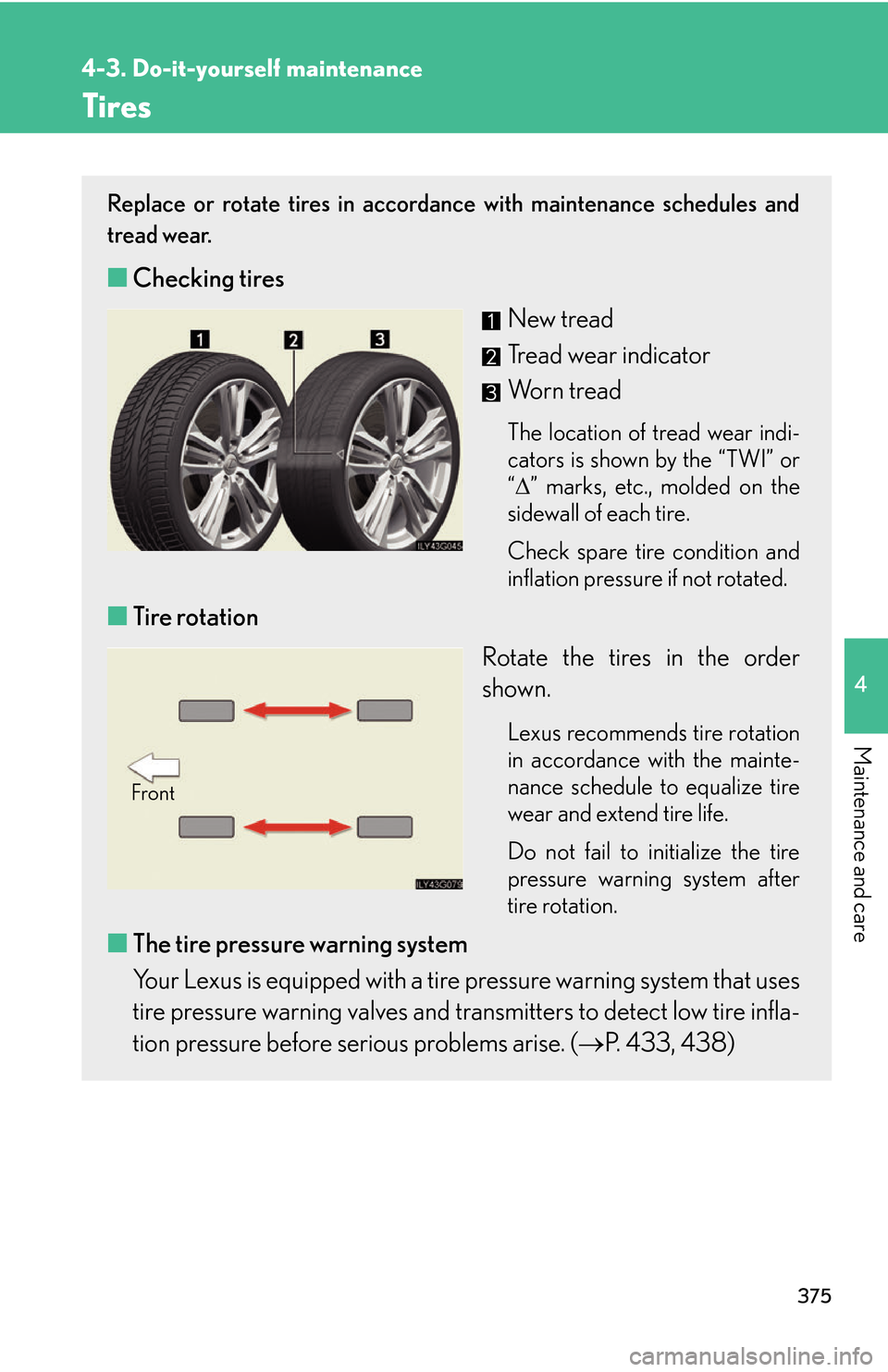Lexus GS450h 2007 Using the audio system / LEXUS 2007 GS450H THROUGH JUNE 2006 PROD. OWNER'S MANUAL (OM30727U)
Manufacturer: LEXUS, Model Year: 2007, Model line: GS450h, Model: Lexus GS450h 2007Pages: 540, PDF Size: 17.11 MB
Page 391 of 540

371
4-3. Do-it-yourself maintenance
4
Maintenance and care
12 volt battery
■Location
The 12 volt battery is located in the
lef
t-hand side of luggage compart-
ment.
■ Ex
terior
Make sure that the battery terminals ar
e not corroded and that there
are no loose connections, cracks, or loose clamps.
Terminals
Hold-down clamp
NOTICE
■If the fluid level is low or high
It is normal for the brake fluid level to go down slightly as the brake pads wear or
when the fluid level in the accumulator is high.
If the reservoir needs frequent refilli ng, it may indicate a serious problem.
Page 392 of 540

372
4-3. Do-it-yourself maintenance
■Before recharging
When recharging, the 12 volt battery produces hydrogen gas which is flammable
and
explosive. Therefore, before recharging:
●If recharging with the 12 volt battery installed on the vehicle, be sure to discon -
nect the ground cable.
●Make sure the power switch on the charger is off when connecting and discon -
necting the charger cables to the battery.
■After recharging/reconnecting the 12 volt battery
In some cases, the hybrid sy stem may
not start. Follow one or both of the following
procedures:
●After opening and closing the driver's door, wait 10 seconds then attempt to
start the hybrid system. (If the system does not start first time, repeat the proce -
dure.)
●With the shift lever in “P” and the powe r switch in the “OFF” mode, open and
close any door, then attempt to start the hybrid system.
If the system will not start even after mult i
ple attempts at both methods, contact
your Lexus dealer.
Page 393 of 540

373
4-3. Do-it-yourself maintenance
4
Maintenance and care
CAUTION
■Chemicals in the 12 volt battery
A battery contains poisonous and corrosive sulfuric acid and may produce hydro-
gen gas which is flammable and explosive. To reduce the risk of death or serious
injury, take the following precautions while working on or near battery:
●Do not cause sparks by touching the battery terminals with tools.
●Do not smoke or light a match near the battery.
●Avoid contact with eyes, skin and clothes.
●Never inhale or swallow electrolyte.
●Wear protective safety glasses when working near the battery.
●Keep children away from the battery.
■Where to safety charge the 12 volt battery
Always charge the battery in an open area. Do not charge the battery in a garage or
closed room where there is not sufficient ventilation.
■How to recharge the 12 volt battery
Only perform a slow charge (5A or less). The battery may explode if charged at a
quicker rate.
■Emergency measures regarding electrolyte
●If electrolyte gets in your eyes
Flush your eyes with clean water for at least 15 minutes and get immediate medi-
cal attention. If possible, continue to apply water with a sponge or cloth while
traveling to the nearest medical facility.
●If electrolyte gets on your skin
Wash the affected area thoroughly. If you feel pain or a burning sensation, seek
medical attention immediately.
●If electrolyte gets on your clothes
It can soak through clothing on to your skin. Immediately take off the clothing and
follow the procedure above if necessary.
●If you accidentally swallow electrolyte
Drink a large quantity of water or milk. Fo llow with milk of magnesia, beaten raw
egg or vegetable oil. Get emergency medical attention immediately.
Page 394 of 540

374
4-3. Do-it-yourself maintenance
Washer fluid
If any washer does not work or the
warning message appears on the
multi-information display, the
washer tank may be empty. Add
washer fluid.
NOTICE
■When recharging the 12 volt battery
Never recharge the battery while the hybrid system is on. Also, be sure all accesso-
ries are turned off.
NOTICE
■Do not use any fluid other than washer fluid
Do not use soapy water or engine antifreeze instead of washer fluid.
Doing so may cause streaking on the vehicle’s painted surfaces.
■Diluting washer fluid
Dilute washer fluid with water as necessary.
Refer to the freezing temperatures listed on the washer fluid tank.
Page 395 of 540

375
4-3. Do-it-yourself maintenance
4
Maintenance and care
Tires
Replace or rotate tires in accordance with maintenance schedules and
tread wear.
■Checking tires
New tread
Tread wear indicator
Worn tread
The location of tread wear indi-
cators is shown by the “TWI” or
“ ”
marks, etc., molded on the
sidewall of each tire.
Check spare tire condition and
inflati
on pressure if not rotated.
■Tire rotation
Rotate the tires in the order
sho
wn.
Lexus recommends tire rotation
in accordance with the mainte -
nance schedule to equalize tire
w
ear and extend tire life.
Do not fail to initialize the tire
pr
essure warning system after
tire rotation.
■ The tire pressure warning system
Your Lexus is equipped with a tire pr
essure warning system that uses
tire pressure warning valves and transmitters to detect low tire infla -
tion pressure before serious problems arise. ( P. 4 3 3, 438 )
Front
Page 396 of 540

376
4-3. Do-it-yourself maintenance
Installing tire pressure warning valves and transmitters
When replacing tires or wheels, tire pressure warning valves and trans-
mitters must also be installed. Tire pr
essure warning valves and transmit-
ters can be installed in any of the following three ways:
● T
ire pressure warning valves and transmitters can be removed from the
old wheels and installed on the new wheels.
● When r
eplacing only the tire, the ti re pressure warning valve and trans-
mitter already installed on the wheel does not need to be replaced.
● R
eplacing both a wheel and its tire pressure warning valve and trans -
mitter.
When new tire pressure warning va lv
es and transmitters are installed,
new tire pressure warning valve and transmitter ID codes must be regis-
tered in the tire pressure warning ECU and tire pressure warning system
must be initializ
ed. (P. 3 7 7, 378 )
Page 397 of 540

377
4-3. Do-it-yourself maintenance
4
Maintenance and care
Initializing the tire pressure warning system
■The tire pressure warning system must be initialized in the following
circumstances:
● When r
otating the tires on vehicles differing with front and rear tire
inflation pressures.
● When changing the tir
e inflation pressure by changing traveling
speed or load weight, etc.
● When changing the tir
e size.
When the tire pressure warning sys tem is initializ
ed, the current tire
inflation pressure is set as the pressure benchmark.
■ Ho
w to initialize the tire pressure warning system
Park the vehicle in safe place and turn the po
wer switch to “OFF”
mode.
While the vehicle is moving, initialization is not performed.
Adjust the tire inflation pressure to the specified cold tire inflation
pressure level. ( P. 4 8 7 )
Make sure to adjust the tire pressure to the specified cold tire inflation
pressure level. The tire pressure warning system will operate based on
this pressure level.
Turn the power switch to “IG-ON” mode.
STEP1
STEP2
STEP3
Page 398 of 540

378
4-3. Do-it-yourself maintenance
Push and hold the tire pressure
warning reset switch until the tire
pressure warning light blinks
slowly three times and the mes-
sage “PRESSURE INITIAL”
appears on the multi-information
display
.
Wait for a few minutes with the “IG-ON” mode, and then turn
power switch to “OFF” mode.
Registering and selecting ID codes
■ Registering ID codes
2 sets of tire pressure warning va lv
e and transmitter ID codes can be
registered. Once a second set of tire s (winter tires etc.) is registered at
“2nd”, you can switch b etween tire set settings si mply by pressing the
tire pressure warning select switch.
There are 2 settings:
“MAIN” position: The ID code of the tir
e pressure warning valve and
transmitter on the tires originally inst alled on the vehicle is registered.
“2nd” position: The code is not registered. When you replace a new set
of tir
es, purchase tire pressure warning valves and transmitters from
your Lexus dealer and have the new ID code registered by your Lexus
dealer.
STEP4
STEP5
Page 399 of 540

379
4-3. Do-it-yourself maintenance
4
Maintenance and care
■Selecting ID codes
When replacing tires, make sure to select the ID code set that matches
the ne
w tire set. If the incorrect ID code is selected, the tire pressure
warning system will not operate properly. After a certain period of
time, the tire pressure warning li ght comes on after blinking for 1
minute to indicate a system malfunction.
“MAIN”
“2nd”
■When to replace your vehicle’s tires
Tires should be replaced if:
●You have tire damage such as cuts, splits, cracks deep enough to expose the
fabric or bulges indicating internal damage
●A tire goes flat repeatedly or cannot be properly repaired due to the size or
location of a cut or other damage
If you are not sure, consult with your Lexus dealer.
■Tire life
Any tire over 6 years old must be checked by a qualified technician even if they
h
ave seldom or never been used or damage is not obvious.
■If the tread wears down below 0.16 in. (4 mm) on snow tires
The effectiveness of snow tires is lost.
■Low profile tires (245/40R18, P245/40R18 and 245/40ZR18 tires)
Generally, low profile tires will wear more rapidly and tire grip performance will be
r
educed on snowy and/or icy roads when co mpared to standard tires. Be sure to
use snow tires or snow chains on snowy and/or icy roads and drive carefully at a
speed appropriate for road and weather conditions.
Page 400 of 540

380
4-3. Do-it-yourself maintenance
■Maximum load of tire
Check that the maximum load of the replaced tire is greater than 1 /2 of the Gross
Axle Weight Ratings (GAWR) of either the front axle or the rear axle, whichever is
greater.
As for the maximum load of the tire, see the load limit at maximum cold tire inflation
pressure mentioned on the sidewall of the tire, and as for the Gross Axle Weight
Ratings (GAWR), see the Certification Label. (
P. 385, 492).
■Tire types
1 Summer tires
Summer tires are high-speed performance tires best suited to highway driving
under dry conditions. Since summer tires do not have the same traction perfor-
mance as snow tires, summer tires are in adequate for driving on snow-covered
or icy roads. For driving on snow-covered roads or icy roads, the use of snow tires
is recommended. When installing snow tires, be sure to replace all four tires.
2 All season tires All season tires are designed to provide better traction in snow and to be ade-
quate for driving in most winter conditions , as well as for use year round. All sea-
son tires, however, do not have adequa te traction performance compared with
snow tires in heavy or loos e snow. Also, all season tires fall short in acceleration
and handling performance compared with summer tires in highway driving.
3Snow tires For driving on snow-covered roads or icy roads, we recommend using snow tires.
If you need snow tires, select tires of the same size, construction and load capac-
ity as the originally installed tires. Since your vehicle has radial tires as original
equipment, make sure your snow tires also have radial construction. Do not install
studded tires without first checking loca l regulations for possible restriction.
Snow tires should be installed on all wheels. ( P. 1 74 )
■Initializing the tire pressure warning system
Initialize the tires with the tire inflatio n pressure adjusted to the specified level.